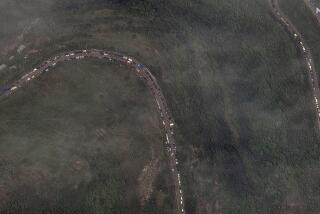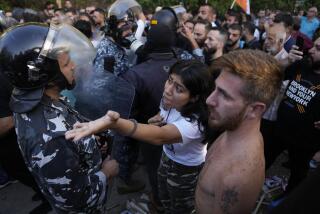American Reporter Visits Closed Soviet Area...
- Share via
LENINAKAN, Soviet Union — A storm blew through Leninakan in Soviet Armenia on a Monday evening, briefly dispersing the throngs of people who had gathered in Theater Square in the city center.
Local estimates put the crowd, which easily filled the tree-lined square, at 50,000. Certainly there were many thousands.
On an ordinary night, a few old men would have collected at the heart of the 2,400-year-old city, about 50 miles north of the Armenian capital of Yerevan, to play checkers and drink the famed local cognac. But this night was different.
It was June 13, the first day of a general strike to press demands for resolution of a territorial dispute. Groups of Armenians wandered up and down Kalinin Street, dropped by Theater Square to hear speeches and mingled with friends.
The city’s center was closed to traffic. Several hundred policemen were on hand to maintain order. They listened to the proceedings and politely directed motorists to side streets.
Prison Sentence Protested
Since late May, crowds had gathered nightly on Theater Square and in many Armenian cities to protest the 15-year prison term given an Azerbaijani convicted of killing Armenians in ethnic riots. Armenians think the sentence was too lenient.
At least 32 people, most of them Armenians, died in three days of rioting in the Azerbaijani city of Sumgait in February.
The strike was called by the Karabakh Committee, a group that coordinates Armenia’s popular protests. Protesters seek annexation of Nagorno-Karabakh, an Armenian-dominated region that has been attached to the republic of Azerbaijan since 1923.
The stoppage was nearly total in Leninakan, a city of more than 170,000. A torrential downpour interrupted the flow of speeches in Theater Square, but only briefly. Within 15 minutes, speakers resumed calls for aid to the victims of the Sumgait riots and urged unification of Nagorno-Karabakh and Armenia.
Placards included official portraits of Soviet leader Mikhail S. Gorbachev.
“Armenia and Nagorno-Karabakh Are One!” proclaimed one red banner in Armenian script.
“We’re very angry that people in Moscow are saying we’re hooligans,” said Tigran, a social worker, who had not been to work that day. He and others interviewed requested only their first names be used.
“Why don’t they show this on television?” he asked. “We’re very peaceful people. . . . If they’d just give us Nagorno-Karabakh, they wouldn’t hear another word from us.”
Workers, factory managers, athletes, Sumgait refugees and others addressed the crowd.
“It is important that we stay organized,” a man named Gevork, who identified himself as a manager of a local factory, told the crowd.
‘Everything We Can’
“We must do everything we can to help the victims of the massacre at Sumgait!” he said. The audience applauded, but a heckler shouted, “Why don’t you make one of your dachas (country homes) available to them?”
Those close enough to hear laughed.
Official figures published Wednesday in the Armenian newspaper Kommunist say 2,527 Armenians have been resettled after leaving Sumgait. The Communist Party’s first secretary in Armenia, Suren G. Arutyunyan, told the republic’s Supreme Soviet that 86 families are still homeless.
The general strike nearly shut down Leninakan for three days, despite official appeals for people to return to work.
But authorities acted to protect the demonstrators. When a few dozen protesters set out on foot for Yerevan, police provided an official escort.
On Wednesday, news spread swiftly of the Armenian Supreme Soviet’s decision to petition Moscow to put Nagorno-Karabakh under Armenian control.
“This is very good news,” said Agonye, a local bureaucrat. “They wouldn’t have made a decision like that without Moscow’s approval.”
But on Friday, the Azerbaijani Supreme Soviet announced that it would oppose any move to take away Nagorno-Karabakh. The dispute is not over yet.
More to Read
Sign up for Essential California
The most important California stories and recommendations in your inbox every morning.
You may occasionally receive promotional content from the Los Angeles Times.













